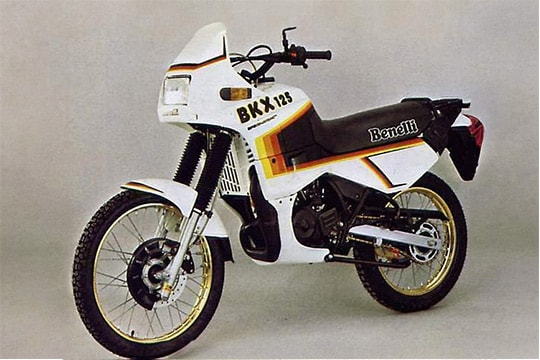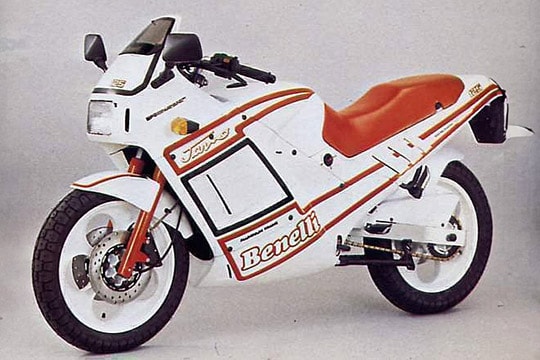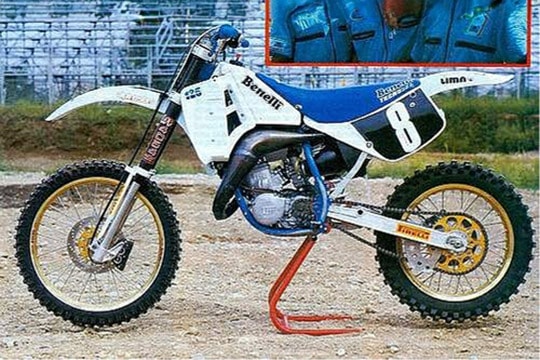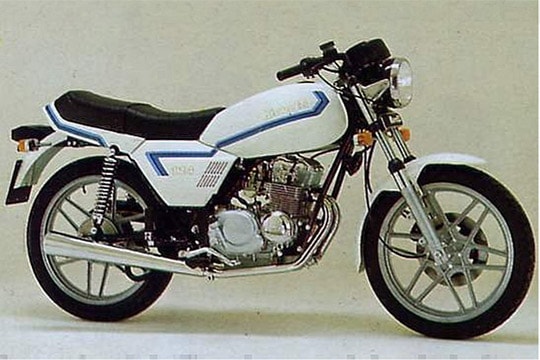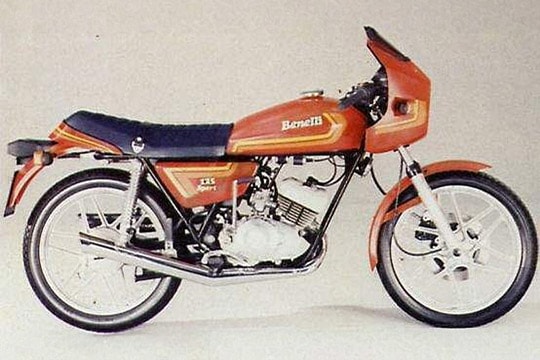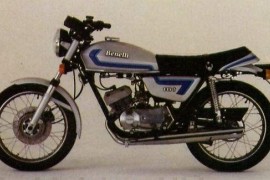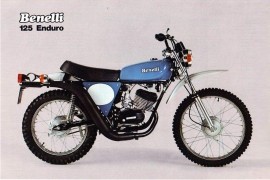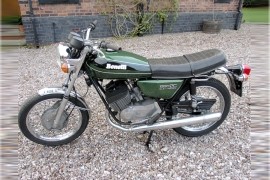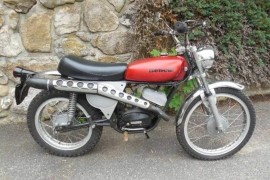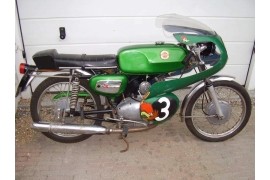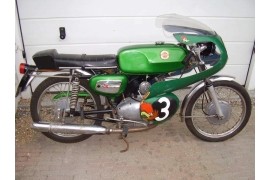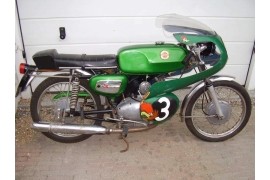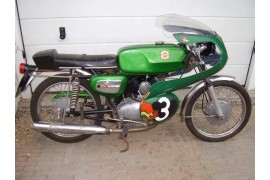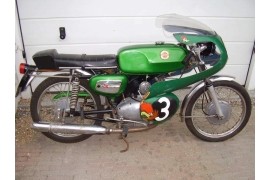BENELLI 125 Models/Series Timeline, Specifications & Photos
First production year: 1967
In 1989, the Italian motorcycle manufacturer launched the Benelli 125 BKX, an off-road motorcycle created by Italian engineers for riders who wanted to spend as much time as possible behind bars on unpaved trails.
The bike's visual department was characterized by standard features, such as a half fairing, a rectangular headlight, a small wind deflector, a one-piece dual seat with a passenger grab rail, a small luggage rack, a side stand, and wire-spoke wheels with off-road tires.
As for the power figures, the 1989 Benelli 125 BKX had its heartbeat set by a 124cc two-stroke air-cooled single-cylinder engine mounted at its core. It was managed by a carburetor and delivered an output power of 24 hp with maximum strength at 9,000 rpm.
The bike's engine was married to a five-speed manual transmission controlled by a wet multi-plate clutch that sent the power generated by the engine to the rear wheel via a final chain drive.
For suspension, the bike packed an air-assisted telescopic fork that handled the front end and an adjustable shock absorber on the rear, providing optimum suspension performance and handling capabilities.
As for the braking power, the bike's wheels were fitted with a single 260 mm brake disc on the front and a 220 mm brake disc on the rear, offering optimum braking performance.
In 1988, the Italian motorcycle maker introduced the Benelli 125 Jarno, a fully faired, small displacement sports motorcycle that debuted in 1988 and was produced for only one year. It was created for those riders looking for a small machine with a sports bike appearance.
The motorcycle had standard features, like a full fairing covering all its internals, a rectangular headlight, a small windscreen, a one-piece dual seat, a single exhaust system with a silencer mounted on the right-hand side, and five-spoke aluminum wheels.
In the performance department, the 1988 Benelli 125 Jarno had its soul brought to life by a 123cc two-stroke single-cylinder air-cooled engine mounted underneath its full fairing, delivering an output power of 30 hp with a peak force at 10,000 rpm.
A five-speed transmission with a wet multi-disc clutch handled the engine's power, sending it to the rear end via a final chain drive and pushing the motorcycle to a top speed of 160 kph (99 mph).
It was manufactured around a steel frame with a 35 mm gas-assisted telescopic fork on the front and an adjustable shock absorber on the rear, providing optimum handling capabilities.
As for the stopping power, the motorcycle packed two 260 mm brake discs bolted to the front wheel and clamped to four-piston calipers. In contrast, the rear wheel was fitted with a 240 mm brake disc, offering optimum stopping power.
In 1987, the Italian motorcycle manufacturer launched the Benelli 125 BX, an off-road small displacement motorcycle created for riders who liked to spend their time on off-road trails.
In the visual department, the motorcycle packed standard features, such as a rectangular headlight integrated into a small cowl, a high-mounted front fender, a small fuel tank, a one-piece dual seat with a passenger grab rail, a small luggage rack, a single exhaust system, and wire-spoke wheels with off-road tires.
The bike was built around a steel frame that housed the suspension system, comprised of a gas-charged telescopic fork on the front with covered sliders and an adjustable shock absorber on the rear, offering optimum suspension performance and handling.
In the braking department, the motorcycle packed a 260 mm brake disc on the 21-inch front wheel and a drum braking unit on the 18-inch rear wheel, delivering optimum stopping power.
In the performance department, the 1987 Benelli 125 BX had installed a 124cc two-stroke single-cylinder air-cooled engine underneath the fuel tank. It was managed by a Dell'Orto carburetor, boasting 24 hp with a peak force at 9,000 rpm.
The power produced by the powerhouse was handled by a five-speed manual transmission controlled by a wet multi-disc clutch and sent to the rear end via a final chain drive.
After the Benelli 125 Sport was introduced in 1981, the Italian motorcycle maker introduced another Benelli 125 Sport model in 1985. It was designed similarly to the 1981 model but featured more modern lines.
Visually, the bike was characterized by standard fittings, like a round headlight upfront, analog instruments, a one-piece dual seat, side-mounted rear shocks, a dual chromed exhaust system with a muffler mounted on each side, and 12-spoke aluminum alloy wheels.
In the performance department, the 1985 Benelli 125 Sport had installed a 125cc four-stroke (as opposed to the two-stroke engine of the 1981 model), air-cooled, two-cylinder engine at its core, boasting 10 hp with maximum strength at 7,600 rpm.
The power generated by the twin-cylinder engine was sent to a five-speed manual transmission that redirected it to the rear wheel through a final chain drive, pushing the small machine to a top speed of 110 kph (68 mph).
The motorcycle was built around a tubular steel frame that housed the suspension system, comprised of a telescopic fork on the front and dual side-mounted shock absorbers on the rear, providing optimum suspension performance and handling.
As for the stopping power, the bike's 12-spoke aluminum alloy wheels were equipped with a 260 mm brake disc clamped to a hydraulic caliper on the front and a 156 mm drum braking unit mounted on the rear.
In 1981, the Italian motorcycle manufacturer introduced the Benelli 125 Sport, a sportier model than other motorcycles in Benelli's range. The motorcycle was manufactured in 1981 and was produced for only one year.
It was a small displacement, entry-level motorcycle that suited various riders, such as the younger, less experienced, and the more seasoned ones.
The bike's visual department was characterized by standard features, such as a single headlight unit integrated into a small front cowl with a small windscreen, a one-piece dual seat, side-mounted rear shocks, a dual exhaust system with a silencer mounted on both sides, and 12-spoke lightweight aluminum alloy wheels.
As for the power figures, the 1981 Benelli 125 Sport had its heartbeat set by a 125cc two-stroke twin-cylinder air-cooled engine mounted at its core, delivering an output power of 10 hp with a peak force at 7,600 rpm.
The bike was built around a tubular steel frame with a telescopic fork on the front, handling the front suspension, and dual side-mounted shock absorbers on the rear, handling the rear-end suspension.
As for the braking power, the motorcycle's 12-spoke aluminum wheels were fitted with a single disc clamped to a hydraulic caliper on the front and a drum braking unit on the rear, providing optimum braking power.
In 1980, the Italian motorcycle maker introduced the Benelli 125 Turismo, an entry-level motorcycle created for those riders who wanted to spend as much time as possible behind the bars. In addition, the bike offered an attractive compromise between economy and performance.
The motorcycle was fitted with standard features in the visual department, such as a round headlight upfront, analog instruments, a one-piece dual seat, side-mounted rear shocks, a single exhaust system with a silencer mounted on the left-hand side, and wire-spoke wheels.
The bike was made around a steel frame that housed a telescopic fork with hydraulic oil dampers on the front and three-way adjustable side-mounted shock absorbers on the rear, delivering optimum suspension performance and handling capabilities.
As for the braking power, the motorcycle's wheels were equipped with a single disc on the front clamped to a hydraulic caliper and a drum braking unit on the rear, offering optimum stopping power.
In the performance department, the 1980 Benelli 125 Turismo had its soul brought to life by a 125cc two-stroke air-cooled single-cylinder engine that delivered 10 hp with a peak at 7,540 rpm and 11 Nm (8 lb-ft) torque at 5,200 rpm.
A five-speed constant mesh manual transmission took the power generated by the engine and sent it to the rear axle through a final chain drive, launching the bike to a maximum speed of 111 kph (69 mph).
In 1980, the Italian motorcycle maker introduced the Benelli 125 Enduro, an enduro motorcycle with more off-road capabilities. The bike debuted in 1980 and was manufactured for only one year.
The bike packed standard features, like a round headlight, analog instruments, a high-mounted front fender on the front, a single seat, a single exhaust system, and wire-spoke wheels shod with off-road tires. In addition, the bike was available in red, black, green, blue, and yellow.
In the performance department, the 1980 Benelli 125 Enduro had its soul brought to life by a 125cc two-stroke air-cooled single-cylinder engine mounted underneath the fuel tank. It was fed by a Dell'Orto carburetor, sending the power generated by the engine to the rear end via a five-speed transmission and a final chain drive, pushing the motorcycle to a top speed of 105 kph (65 mph).
The bike was manufactured around a welded, tubular twin-downtube cradle steel frame with a telescopic fork on the front and dual side-mounted adjustable shock absorbers on the rear, providing optimum suspension performance and handling capabilities.
As for the braking power, the motorcycle's wheels were fitted with a 135 mm drum braking unit on the 21-inch front wheel and a 135 mm drum braking unit on the 18-inch rear wheel, providing optimum stopping performance.
In 1979, the Italian motorcycle maker launched the Benelli 125 2C, a small displacement, entry-level motorcycle best suited for younger and less-experienced riders among Benelli's fans. The bike was produced for only one year.
In the visual department, the motorcycle packed standard features, such as a round headlight with a chromed housing, a chromed front fender, a one-piece dual seat, dual side-mounted rear shocks, a dual exhaust system with a silencer mounted on both sides, and wire-spoke wheels.
The 1979 Benelli 125 2C was powered by a 124cc two-stroke air-cooled twin-cylinder engine mounted underneath the fuel tank. It was fed by a Dell'Orto carburetor and delivered an output power of 17 hp with maximum strength at 8,000 rpm.
The power produced by the engine was handled by a five-speed manual transmission and was sent to the rear end via a final chain drive, launching the motorcycle to a top speed of 104 kph (65 mph).
For suspension, the motorcycle was fitted with a telescopic fork on the front and dual side-mounted shock absorbers on the rear, providing optimum suspension performance and handling capabilities.
In the braking department, the motorcycle packed a single brake disc clamped to a hydraulic caliper on the front wheel and a drum braking unit on the rear wheel, offering optimum stopping performance.
The Benelli 125 Panther was a dual-purpose entry-level motorcycle that debuted in 1974 and manufactured for only one year. The bike was capable of tackling both paved and unpaved roads.
In 1974, the Italian motorcycle maker launched the Benelli 125 Panther, a small displacement motorcycle that suited the younger and less-experienced riders among Benelli's fans.
The bike's appearance was characterized by standard features, such as a round headlight with a chromed housing, a chromed front fender, a one-piece dual seat, a single exhaust system mounted high on the right-hand side, dual side-mounted shocks on the rear, and wire-spoke wheels with off-road tires.
The bike was built around a steel frame with a Marzocchi telescopic fork on the front and dual Marzocchi shock absorbers on the rear, delivering optimum suspension performance and handling capabilities.
In the braking department, the bike's 21-inch front spoke wheel was fitted with a 135 mm drum braking unit, and the rear spoke wheel was equipped with a 135 mm drum braking unit, offering optimum stopping power.
As for the power figures, the 1974 Benelli 125 Panther had its soul brought to life by a 125cc two-stroke air-cooled single-cylinder engine fed by a Dell'Orto carburetor. The power generated by the engine was sent to the rear via a five-speed transmission and a final chain drive.
In 1972, the Italian motorcycle manufacturer released the Benelli 125 Sport Special, an entry-level small displacement motorcycle that debuted in 1968 and continued production until 1973.
The 1972 motorcycle came in the same shape and form as the previous one, delivering the same technical, visual, and performance specifications without significant modifications whatsoever.
The bike's appearance department was characterized by standard features, such as a half fairing with a large windscreen, a one-piece dual seat, two side-mounted rear shocks, a single exhaust system with a muffler mounted on the right-hand side, a center stand, and wire-spoke wheels.
The 1972 Benelli 125 Sport Special was set in motion by a 123cc four-stroke single-cylinder air-cooled engine mounted underneath its long fuel tank, boasting 12 hp with a peak force at 8,500 rpm.
A five-speed manual transmission took the power generated by the engine and sent it to the rear end via a final chain drive, pushing the motorcycle to a top speed of 130 kph (81 mph).
The motorcycle was manufactured around an open cradle steel tube frame with a telescopic fork on the front and dual side-mounted hydraulic shock absorbers on the rear, providing optimum suspension performance and handling capabilities.
As for the braking power, the motorcycle's 18-inch wheels were fitted with a 175 mm drum braking unit on the front and a 125 mm drum braking unit on the rear, offering optimum braking performance.
In 1971, the Italian motorcycle manufacturer released the Benelli 125 Sport Special, an entry-level motorcycle that debuted in 1968 and continued production until 1973. It was created after Benelli's and Motobi's merger in 1962 alongside a slightly larger 250cc version.
The 1971 model came in the same shape and form as the previous one, delivering the same technical, visual, and performance specifications without any modifications whatsoever.
The bike's aesthetic department was characterized by standard fittings, like a half fairing with a large windscreen, a one-piece dual seat, two side-mounted rear shocks, a single exhaust system with a muffler mounted on the right-hand side, a center stand, and wire-spoke wheels.
In the performance department, the 1971 Benelli 125 Sport Special had its heartbeat set by a 123cc four-stroke single-cylinder air-cooled engine mounted underneath its long fuel tank, boasting 12 hp with a peak force at 8,500 rpm.
The power generated by the engine was transferred to the rear end via a five-speed transmission and a final chain drive, launching the motorcycle to a top speed of 130 kph (81 mph).
The bike was made around an open cradle steel tube frame with a telescopic fork on the front and dual side-mounted hydraulic shock absorbers on the rear, offering optimum suspension performance and handling.
As for the stopping power, the bike's 18-inch wire-spoke wheels were fitted with a 175 mm drum braking unit on the front and a 125 mm drum braking unit on the rear, providing optimum braking performance.
In 1962, Benelli and Motobi merged and produced a series of 125 and 250cc motorcycles sold under both names and marketed under the "sport Special" designation. The 125cc models came in silver and red, whereas the 250 versions were painted silver and yellow.
In 1970, the Italian motorcycle maker released the Benelli 125 Sport Special, an entry-level motorcycle with superior performance. It was in its third consecutive production and featured the same characteristics as the previous one.
The 1970 Benelli 125 Sport Special was powered by a 123cc four-stroke single-cylinder air-cooled engine mounted underneath its long fuel tank, boasting 12 hp with a peak force at 8,500 rpm.
The bike's power was handled by a five-speed transmission and a final chain drive, delivering it to the rear wheel, pushing the motorcycle to a top speed of 130 kph (81 mph).
The bike was built around an open cradle steel tube frame with a telescopic fork on the front and dual side-mounted hydraulic shock absorbers on the rear, offering optimum suspension performance and handling.
The bike was built around an open cradle steel tube frame with a telescopic fork on the front and dual side-mounted hydraulic shock absorbers on the rear, offering optimum suspension performance and handling.
In the aesthetic department, the motorcycle packed standard features, like a half fairing with a large windscreen, a one-piece dual seat, two side-mounted rear shocks, a single exhaust system with a muffler mounted on the right-hand side, a center stand, and wire-spoke wheels.
The Benelli 125 Sport Special was a small displacement motorcycle created after the merger of Benelli and Motobi in 1962. It was made in 125 and 250cc versions, and the 125cc models came in silver and red, whereas the 250 versions were painted silver and yellow.
In 1969, the Italian motorcycle maker released the Benelli 125 Sport Special, a motorcycle in its second production year. It was fitted with an aerodynamic half fairing and continued production until 1973.
The 1969 model came in the same shape and form as the previous one, delivering the same technical, visual, and performance specifications without any modifications whatsoever.
The bike's aesthetic department was characterized by standard fittings, like a half fairing with a large windscreen, a one-piece dual seat, two side-mounted rear shocks, a single exhaust system with a muffler mounted on the right-hand side, a center stand, and wire-spoke wheels.
As for the power figures, the 1969 Benelli 125 Sport Special had its soul brought to life by a 123cc four-stroke single-cylinder air-cooled engine underneath its long fuel tank, boasting 12 hp with a peak force at 8,500 rpm.
The power generated by the powerhouse was redirected to the rear end via a five-speed transmission and a final chain drive, pushing the motorcycle to a maximum speed of 130 kph (81 mph).
In 1962, Benelli and Motobi merged and produced a series of 125 and 250cc motorcycles sold under both names and marketed under the "sport Special" designation. The 125cc models came in silver and red, whereas the 250 versions were painted silver and yellow.
In 1968, the Italian motorcycle maker released the Benelli 125 Sport Special, a half-faired motorcycle fitted with an aerodynamic fairing. The bike debuted in 1968 and was manufactured until 1973.
In the visual department, the motorcycle packed standard features, such as a half fairing with a large windscreen, a one-piece dual seat, two side-mounted rear shocks, a single exhaust system with a muffler mounted on the right-hand side, a center stand, and wire-spoke wheels.
The bike was built around an open cradle steel tube frame with a telescopic fork on the front and dual side-mounted hydraulic shock absorbers on the rear, offering optimum suspension performance and handling.
As for the braking power, the bike's 18-inch wire-spoke wheels were fitted with a 175 mm drum braking unit on the front and a 125 mm drum braking unit on the rear, providing optimum braking performance.
In the performance department, the 1968 Benelli 125 Sport Special had installed a 123cc four-stroke single-cylinder air-cooled engine underneath its long fuel tank, boasting 12 hp with a peak force at 8,500 rpm.
In 1962, Benelli and Motobi merged and produced a series of 125 and 250cc motorcycles sold under both names and marketed under the "sport Special" designation. The 125cc models came in silver and red, whereas the 250 versions were painted silver and yellow.
In 1973, the Italian motorcycle maker released the Benelli 125 Sport Special, an entry-level small displacement motorcycle in its sixth consecutive production year, packing the same characteristics as previous models, without any changes.
The bike's aesthetic department was characterized by standard features, such as a round headlight, analog instruments, a long fuel tank, a one-piece dual seat, side-mounted rear shocks, a single exhaust system with a muffler mounted on the right-hand side, and wire-spoke wheels.
The bike was built around an open cradle steel tube frame with a telescopic fork on the front and dual side-mounted hydraulic shock absorbers on the rear, offering optimum suspension performance and handling.
As for the stopping power, the bike's 18-inch wire-spoke wheels were fitted with a 175 mm drum braking unit on the front and a 125 mm drum braking unit on the rear, providing optimum braking performance.
Performance-wise, the 1973 Benelli 125 Sport Special had its heartbeat set by a 123cc four-stroke single-cylinder air-cooled engine mounted underneath its long fuel tank, boasting 12 hp with a peak force at 8,500 rpm.
